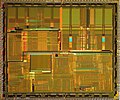Intel i960

Intel i960 processor in PGA housing
|

Intel N80960SA in a PLCC housing.
|

Intel GC80960RD66 in BGA housing.
|
|

The one 80960HD
|
|

mylex 3-channel Ultra SCSI RAID controller with i960 (GC80960RD66)
|
|
Intel i960 (also Intel 80960 ) is a RISC -based microprocessor design from Intel . It was during the 1990s as Embedded - Microcontrollers quite successful for some time, so much so that it's AMD AM29000 displaced from the top of this market. Despite this success, sales of the i960 ceased in the late 1990s due to a contract with Digital Equipment Corporation that allowed Intel to use the design of the StrongARM CPU.
prehistory
The i960 design can be seen as Intel's advancement of the in-house, doomed iAPX-432 design of the early 1980s. The idea behind the iAPX 432 was direct support for "high-level" functions such as tagged and protected memory or garbage collection in hardware. Due to the complexity of the instruction set , its multi-chip implementation and other design weaknesses, the iAPX 432 was very slow compared to other processors of its time.
In 1984, Intel and Siemens started a joint project called BiiN to develop a fault-tolerant, object-oriented high-end computer system that was to be programmed entirely in Ada . Many of the members of the i432 team also worked on this project. The targeted market for the BiiN system were users of high-availability computer systems such as banks, industry and nuclear power plants .
The i432 memory protection system influenced the design of the BiiN system.
architecture
In order to avoid the performance problems of the i432, the processor was implemented in the RISC design. The memory bus was 33 bits wide (a 32-bit data word and a “marker bit” for memory protection). The i960 followed the Berkeley RISC design in many respects , for example in the use of register windows , an implementation-specific number of caches for the "per-subroutine" registers for fast routine calls. Unlike the i386 , but like most other 32-bit designs, the i960 had a 32-bit address space with no memory segmentation. There was also a superscalar implementation of the i960 architecture with instructions that were distributed simultaneously to several units in the processor.
They are mostly used in network components , RAID systems, terminal computers or imaging devices such as printers . They are designed for the rapid recording, processing and transfer of data.
Web links
- i960 processors. www.intel.com, accessed October 12, 2011. (English)

